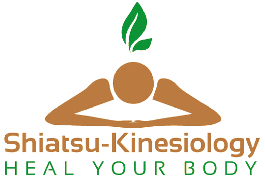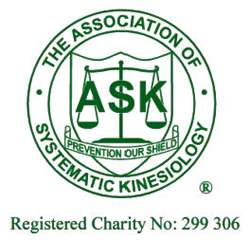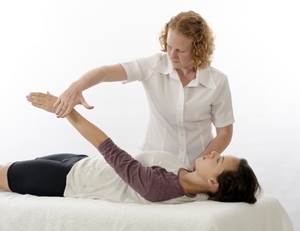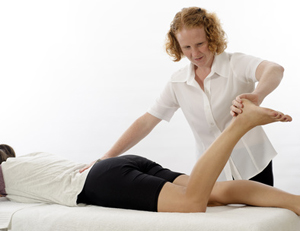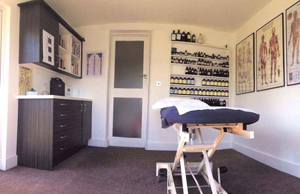What is Systematic Kinesiology?
The basic tool within kinesiology is the muscle test, which is testing the patient’s ability to hold a muscle against light pressure. Initially, a series of muscles will be tested which will highlight which area to focus on. The arms, legs or head will be placed into specific positions and light pressure applied against the muscle being tested. Each muscle is related to an organ, and also to a Meridian (an energy pathway – see more on this under ‘Shiatsu’). Together the muscle, organ and Meridian form a ‘circuit’. If there are chemical, emotional, structural or energetic stresses affecting the circuit, the muscle tested will feel ‘spongy’ or will go weak when light pressure is applied – this indicates an imbalance in that circuit which will then be further investigated to find out what factors are aggravating the imbalance, and what will help to restore balance. A variety of techniques used by acupuncturists, chiropractors, cognitive and nutritional therapists are used to help correct the problem.
Various factors can have an effect on the muscle’s response; a bit like switching the muscle on or off. For example talking or thinking about an emotional stress or trauma can cause a muscle to suddenly be able to hold against the pressure (when previously it tested weak). This indicates that that particular stress/trauma is involved in the body’s imbalance.
Similarly, if a particular nutrient, when placed in the mouth or on the jaw, causes the muscle to ‘switch on’, that would indicate it to be helpful to the body. Or, if testing to find out if there are any food sensitivities involved, then samples can be placed on the jaw to be tested, and likewise this can switch a muscle ‘on’ or ‘off’ indicating whether food is a problem to the body or whether it is something which will help heal the body. The same process can be used to find related structural problems, and energetic factors that are involved.
Based on feedback from the body, the practitioner and the client can discover exactly what is involved in the imbalance and devise a treatment plan. It may include nutritional supplements, herbs, homeopathy, various emotional stress release techniques (such as EFT Emotional Freedom Technique), Bach Flower Remedies, acupressure, gentle structural realignment, stimulation of various vascular points, firm lymphatic reflex massage, suggested lifestyle changes, simple exercises or techniques to practice at home. The exact treatment plan will be very individual.
Sessions
The number of sessions depends on the individual’s health issues or complaints, such as how long standing the problem is and how fully they participate in their own treatment (i.e. engaging in the suggested lifestyle/dietary changes that often form part of a plan). Changes can be felt immediately, however most people feel noticeable improvement in three to six visits. To feel maximum benefit, it is recommended to have the first three sessions fairly close together (maximum gap weekly) in order for the achieved balance not to slip backwards and necessitate reworking. Once better health has been achieved, it is good to have routine balances two to three times per year or as and when health issues crop up.
Please wear loose, comfortable (preferably natural fibre) clothing. It is advisable to abstain from alcohol on the day of a treatment, and to remember the importance of drinking plenty of good quality water
History of Applied Kinesiology and Systematic Kinesiology
Kinesiology comes from the Greek word kinesis, which means motion. In the medical sciences it is the name given to the study of muscles and the movement of the body, the mechanics of body movements.
Dr George Goodheart, an American chiropractor, the acknowledged founder of Applied Kinesiology in 1964, used the model of muscle testing to evaluate what he was doing chiropractically. The model of muscle testing he used was developed in the 1930s by the husband and wife team of Kendal and Kendal.
In neurology textbooks muscle testing is defined as “a means of testing the motor function of limbs”. Therefore muscle testing was already accepted as a valid technique and used extensively in orthopaedic medicine by physiotherapists, chiropractors and osteopaths.
As interest grew in utilising this technique Dr Goodheart drew together a group of doctors who were also interested in developing this further and the International College of Applied Kinesiology (ICAK) was formed in 1973. As part of the foundation of expanding the application of muscle testing, the team took on board work done by Drs Bennet and Chapman with regard to the lymphatic and vascular systems. They also looked at the subtle energy system as used within acupuncture.
This then was the basis of muscle testing that was to develop and become known as Applied Kinesiology (AK).
In 1964 Dr. Goodheart made the first correlation between finding a weak muscle using manual muscle testing and then employing chiropractic therapy to make it stronger. He then looked beyond the chiropractic profession to the fields of biomedicine, osteopathy, acupuncture, dentistry, nutrition, biochemistry, and others for methods to increase the health and well-being of patients based on using the body itself as a diagnostic tool.
Applied Kinesiology was the name given by Dr George Goodheart, to the system of applying muscle testing diagnostically and therapeutically to different aspects of health care. AK refers only to the parent system, as taught by the International College of Applied Kinesiology (ICAK). The ICAK only accepts students with medical or scientific qualifications. AK is regulated and governed by the ICAK in the USA. Because of its chiropractic background, most people training in AK already have training in manipulative skills, including many chiropractors in the USA and some chiropractors and osteopaths in the UK. Only candidates with 4 years’ full-time training in medicine or the medical sciences, who have a licence to diagnose, may apply for training and membership of ICAK.
Sheldon Deal, with John Thie, had a vision of making Kinesiology techniques available to both medical and non-medical people, who could usefully learn and share them with others. Whereas John Thie created a synthesis of early developments of AK and called it Touch For Health (TFH), Sheldon Deal has created a synthesis of the ongoing developments of AK, which he called Advanced Kinesiology and which omits manipulative corrections carried out by chiropractors and osteopaths.
In recent years the orientation of the TFH Foundation has changed, and it has become a research organisation. The Academy of Systematic Kinesiology (TASK) was formed by Brian Butler in 1982 to educate the public in basic and advanced Kinesiology. Brian was a pioneer in bringing TFH to Europe in 1976. Systematic Kinesiology is the name he gave to a training programme, which teaches Balanced Health, (based on TFH) and the intermediate and advanced Kinesiology techniques taught by Dr Sheldon Deal. This is the type of Kinesiology practiced by those who train under TASK and ASK.
